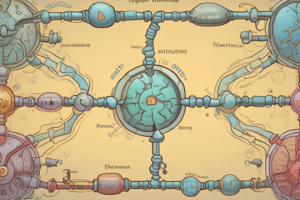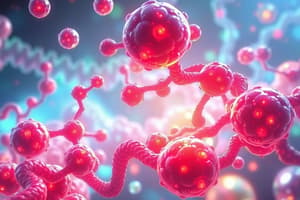Podcast
Questions and Answers
What is the primary physiological role of serotonin?
What is the primary physiological role of serotonin?
- Increases heart rate
- Affects melanin production
- Regulates pain and sleep (correct)
- Regulates blood sugar levels
Which step is considered the rate limiting step in the synthesis of catecholamines?
Which step is considered the rate limiting step in the synthesis of catecholamines?
- Tyrosine decarboxylation
- Degradation of catecholamines
- Conversion of DOPA to dopamine
- Tyrosine hydroxylation to DOPA (correct)
What catalyzes the inactivation of catecholamines?
What catalyzes the inactivation of catecholamines?
- Catechol-O-methyl transferase (COMT) (correct)
- Lipase
- Acetylcholinesterase
- Dipeptidyl peptidase
Where are catecholamines synthesized apart from the brain and CNS?
Where are catecholamines synthesized apart from the brain and CNS?
What substance is produced from the decarboxylation of histidine?
What substance is produced from the decarboxylation of histidine?
What increases the solubility of bilirubin in hepatocytes?
What increases the solubility of bilirubin in hepatocytes?
Which condition leads to hepatocellular jaundice?
Which condition leads to hepatocellular jaundice?
What is the role of creatine kinase during muscular contraction?
What is the role of creatine kinase during muscular contraction?
Which is a product of the hydrolysis and reduction of bilirubin diglucuronide in the intestine?
Which is a product of the hydrolysis and reduction of bilirubin diglucuronide in the intestine?
Which condition is attributed to a decrease in bilirubin glucuronyl transferase activity?
Which condition is attributed to a decrease in bilirubin glucuronyl transferase activity?
What indicates a potential myocardial infarction in clinical settings?
What indicates a potential myocardial infarction in clinical settings?
What is the primary indication of creatinine levels in urine?
What is the primary indication of creatinine levels in urine?
What is the main function of the enzyme ALA synthase in porphyrin biosynthesis?
What is the main function of the enzyme ALA synthase in porphyrin biosynthesis?
Which compound is synthesized from glycine, arginine, and methionine?
Which compound is synthesized from glycine, arginine, and methionine?
Which compound is formed by the condensation of four molecules of porphobilinogen?
Which compound is formed by the condensation of four molecules of porphobilinogen?
What inhibits the activity of ALA synthase during porphyrin biosynthesis?
What inhibits the activity of ALA synthase during porphyrin biosynthesis?
Where does the majority of heme biosynthesis occur in the human body?
Where does the majority of heme biosynthesis occur in the human body?
What is the final product of heme degradation?
What is the final product of heme degradation?
Which of the following compounds is NOT synthesized from amino acids?
Which of the following compounds is NOT synthesized from amino acids?
What role does heme play in biological systems?
What role does heme play in biological systems?
The initial reaction in the degradation of heme generates which products?
The initial reaction in the degradation of heme generates which products?
Flashcards
Porphyrins
Porphyrins
Cyclic compounds that bind metal ions, typically Fe+2 or Fe+3. They are crucial in various biological processes involving oxygen transport and metabolism.
Heme
Heme
A prosthetic group of hemoglobin, myoglobin, cytochromes, catalase, and tryptophan pyrrolase. Responsible for oxygen binding and electron transport.
Heme Degradation
Heme Degradation
The breakdown and removal of heme from the body. This process results in the production of bilirubin, a yellow pigment that gives bile its characteristic color.
Heme Oxygenase
Heme Oxygenase
Signup and view all the flashcards
Biliverdin
Biliverdin
Signup and view all the flashcards
ALA Synthase
ALA Synthase
Signup and view all the flashcards
Porphobilinogen Formation
Porphobilinogen Formation
Signup and view all the flashcards
Heme Formation
Heme Formation
Signup and view all the flashcards
Jaundice
Jaundice
Signup and view all the flashcards
Creatine Phosphate
Creatine Phosphate
Signup and view all the flashcards
Creatine Kinase
Creatine Kinase
Signup and view all the flashcards
Creatinine
Creatinine
Signup and view all the flashcards
Histamine
Histamine
Signup and view all the flashcards
Formation of Bilirubin Diglucuronide
Formation of Bilirubin Diglucuronide
Signup and view all the flashcards
Bilirubin Glucuronyl Transferase
Bilirubin Glucuronyl Transferase
Signup and view all the flashcards
Serotonin
Serotonin
Signup and view all the flashcards
Catecholamines
Catecholamines
Signup and view all the flashcards
Tyrosine Hydroxylase
Tyrosine Hydroxylase
Signup and view all the flashcards
Melanin
Melanin
Signup and view all the flashcards
Study Notes
Nitrogen Metabolism
- Nitrogen disposal is handled by the urea cycle.
- The breakdown of carbon skeletons from nitrogen-containing substances is also important.
- Examples of N-containing substances include:
- Porphyrins, including heme
- Creatine
- Histamine
- Serotonin
- Catecholamines
- Melanin
Porphyrins
- Porphyrins are cyclic compounds that bind metal ions, typically iron (Fe2+ or Fe3+).
- Porphyrins are crucial components of numerous proteins.
- Metaloporphyrins, including heme, are essential groups in hemoglobin, myoglobin, cytochromes, catalase, and tryptophan pyrrolase.
- Heme is synthesized and broken down at a rate of 6-7 grams daily.
- The structure of porphyrins involves four pyrrole rings linked by a methylene bridge.
- Different porphyrins have various side chains attached to the pyrrole rings.
- Porphyrin types include I, II, III, and IV, each with distinct side chain distributions.
- Porphyrins are synthesized in the liver, and the first reaction and last three reactions occur in the mitochondria, while others occur in the cytosol.
- Formation of 8-amino levulinate (ALA) is a vital step as this reaction is catalyzed by ALA synthase which is the rate-limiting step in the synthesis of porphyrins.
- ALA synthase is inhibited by heme.
- Two ALA molecules condense to form porphobilinogen via ALA dehydratase enzyme.
- Uroporphyrinogen is formed by the condensation of four porphobilinogens.
- Uroporphyrin III is then converted to heme through decarboxylation.
- Heme's structure involves a ferrous ion coordinated within the porphyrin.
Degradation of Heme
- Red blood cells (RBCs) have a lifespan of 120 days.
- Senescent RBCs are broken down in the spleen and liver by macrophages.
- Heme oxygenase, an enzyme, catalyzes the first step in heme degradation.
- The process results in the release of carbon monoxide (CO), biliverdin, and iron.
- Biliverdin is then reduced to bilirubin.
- Bilirubin is transported bound to albumin in the blood.
- Hepatocytes take up bilirubin and add glucuronic acid to it.
- Bilirubin diglucuronide (conjugated bilirubin) is water-soluble and excreted in bile.
- Bacteria in the intestines convert bilirubin diglucuronide to urobilinogen.
- Urobilinogen is then converted to either urobilin or stercobilin, which are excreted in urine and feces respectively.
Creatine
- Creatine phosphate is a high-energy compound found in muscles.
- It acts as a reservoir, storing energy to replenish ATP during periods of intense muscle contraction.
- The rate of creatine phosphate formation is proportional to ATP requirements and thus is high in muscle tissue.
- Creatine kinase (CK) activity in the blood is used diagnostically in cases of myocardial infarction.
- Creatine is synthesized from glycine, arginine, and methionine, primarily in the kidney, liver, and pancreas.
Degradation of Creatine
- Creatine and phosphocreatine spontaneously cyclize to form creatinine, a waste product.
- Creatinine excretion in urine is directly related to the total body mass.
- Elevated creatinine levels in urine indicate possible kidney dysfunction.
Histamine
- Histamine serves as a chemical messenger mediating various cellular responses, including allergic reactions, inflammation, and controlling gastric acid secretion, and neurotransmitter function in the brain.
- It's produced by decarboxylation of histidine.
- Mast cells release histamine in response to allergies.
- Antihistamines are used to counter histamine's effects.
Serotonin
- Serotonin is synthesized from tryptophan.
- It's stored in various parts of the body, including the small intestine, platelets, and the central nervous system (CNS).
- Serotonin plays multiple physiological roles, influencing pain perception, blood pressure regulation, temperature, and sleep.
Catecholamines
- Dopamine, norepinephrine, and epinephrine are classified as catecholamines.
- Catecholamines function as neurotransmitters within the brain and central nervous system (CNS).
- These compounds are crucial components of the "fight-or-flight" response.
- Norepinephrine and epinephrine are synthesized in the adrenal medulla.
- Catecholamines are inactivated by oxidative deamination (MAO) and O-methylation (COMT).
Melanin
- Melanin is a pigment found in various tissues, such as the skin, eyes, and hair.
- Melanocytes are the skin cells responsible for melanin production.
- Melanin protects tissues from the damaging effects of ultraviolet (UV) light.
- Tyrosine is a precursor molecule in melanin synthesis.
Jaundice
- Jaundice results from high bilirubin levels in the blood.
- It manifests as a yellowing of the skin and sclera (whites of the eyes).
- There are various types of jaundice, including hemolytic jaundice (due to excessive red blood cell destruction), obstructive jaundice (due to bile duct blockage), and hepatocellular jaundice (due to liver damage.
- Jaundice can be observed in newborns due to immaturity of bilirubin glucuronyl transferase, an enzyme critical for bilirubin conjugation.
Studying That Suits You
Use AI to generate personalized quizzes and flashcards to suit your learning preferences.




